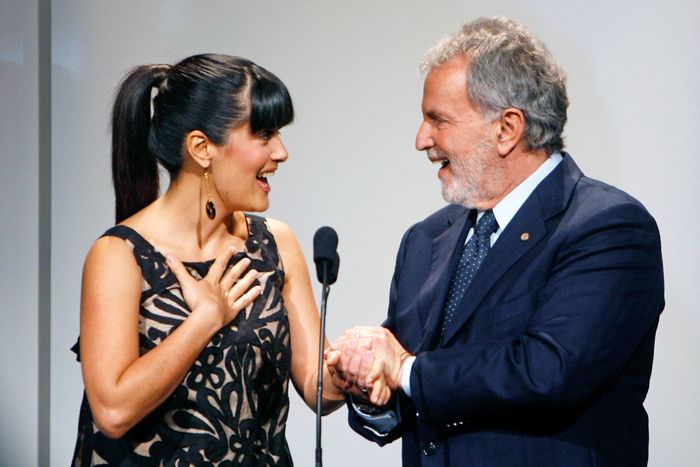
Wednesday’s announcement that married beautifuls Priyanka Chopra and Nick Jonas will be the presenters for Monday morning’s Oscar nominations was met mostly with a flurry of treatises on the pair’s relative levels of fame and prestige. Are they worthy enough actors to be associated so closely with Oscar adjacency, or are they just the two most photogenic faces willing to be on camera at 5:00 a.m. PT on a Monday, the morning after Daylight Saving? But these are not the important considerations. Or, they’re merely secondary considerations. As the Priyankas and Nicks of the world get asked to put some zazz (™ The Prom 2020) into Oscar nomination morning, it’s important to collectively mourn what we’ve lost as the Academy has moved so far away from the ideal morning-nomination scenario: the Academy president and an Oscar-winning actress presenting the nominees from a podium in front of some video monitors. Every evolution away from that format has sacrificed tradition and gravitas for cheap sparkle, and we should take a moment to commemorate its passing.
In the late 1980s, the announcement of the Academy Award nominations had graduated from the trade papers and moved to TV. Broadcast on the network morning shows like Today and Good Morning America, as well as on cable, where E! made as much a meal of the event as was practical at the time, bringing in awards “experts” and snagging immediate reaction interviews from the nominees, they were — and remain today — a glorified reading of a press release. And since the format of the press event stayed the same for more than two decades, it took on the sheen of tradition.
The elements were simple yet very consistent: At the ungodly hour of 5:30-ish a.m. Pacific time, whoever was the Academy president at the time would join a Hollywood performer at a podium, in front of a quintet of video screens, and begin reading the nominees in the major categories (Picture, Director, all four acting categories, the screenplays, and Foreign Language Film; eventually joined by Animated Feature). Far more often than not, the performer joining the Academy president was an Oscar-winning actress, lending gravitas and glamor to the moment. Anjelica Huston, Shirley MacLaine, Sigourney Weaver, Kathy Bates, Mira Sorvino, and Marcia Gay Harden all took on the assignment at one time or another. The dryness of the format was a feature, not a bug, and it allowed the little ephemeral things to pop. And if Oscar obsessives love anything, it’s making a big deal out of ephemera. The way that Weaver opened the 76th Oscars press event with a directive to “hold onto your hats” (she wasn’t kidding, either, as that year’s announcements included shockers like Whale Rider’s Keisha Castle-Hughes in Best Actress and City of God’s Fernando Meirelles in Best Director). The way the gathered press and publicists in the peanut gallery shrieked in approval when Javier Bardem got his first ever nomination for Before Night Falls.
In 2007, announcing the nominees for the best films from 2006, Salma Hayek (not an Oscar winner but a former nominee for Frida) took to the stage and gave what is to date the finest performance from an actress reading the Oscar nominations in history. There were dramatic pauses, bursts of elation (like when her bestie Penélope Cruz got a Best Actress nod for Volver), and a emotional climax full of tears and poignancy when Mexico’s Pan’s Labyrinth was nominated for Best Foreign Language Film (followed immediately by a return to deadpan stoicism for the final nominee, Canada’s Water). It was a bravura turn by Hayek, and I submit to you that its heightened air of high drama amid a bureaucratic backdrop would not have been possible in the modern-day nomination format.
The contemporary history of the Academy Awards is a story of nervous pivoting in the hopes of staving off audience erosion. Attempts have been made to add dubious new categories, pack the show with youth appeal, nab every possible Avenger to be a presenter, and go hostless in order to make the telecast as short as possible. Unsurprisingly, the stoicism of nomination morning became a target of tinkering before too long. The 2013 announcement saw that year’s host Seth MacFarlane joined by Emma Stone for a 10-minute affair that positively groaned under the weight of all the bits, banter, and comedy forced upon their captive pre-sunrise audience. MacFarlane opened with a monologue, and Stone managed to kill the suspense of the Supporting Actor category with a bit noting each nominee as a previous winner.
The Academy has since backed off from anything resembling that year’s live theater, settling into what has been for the last few years a pretaped streaming-video presentation hosted by the likes of Tiffany Haddish, Kumail Nanjiani, and Issa Rae. And while there should be zero complaints about the talent involved — particularly when discussing the backspin Haddish put on the phrase “Call Me By Your Name” — there is something overly produced and airless about the new format. Look no further for proof than the fact that the single most memorable moment from the last ten years of Oscar announcements came when they reverted to the old format for the 2015 announcement: Academy president Cheryl Boone Isaacs, joined by Chris Pine (not an actress, but so pretty!), reading the nominations for Best Cinematography and misreading Mr. Turner’s Dick Pope as Dick Poop.
One of these days, the Academy will end up pulling the trigger on an all-out nominations special aired in prime time. It’s a near certainty. It’ll be an hour long and feature six man-on-the-street bits from Jimmy Kimmel, and the identities of the nominees will be guessed Masked Singer–style by the hosts of The View. It’ll be a circus, and we’ll all hate-watch it, but we’ll have lost something. A moment like “Dick Poop” only comes around once in a generation. Salma Hayek’s devastating “… andfromCanadaWater” is a comet shooting across the night sky. They are moments of folly and fabulousness against the backdrop of an early-morning chore. You’re not gonna get that with Priyanka and Nick doing pretaped banter on YouTube.


